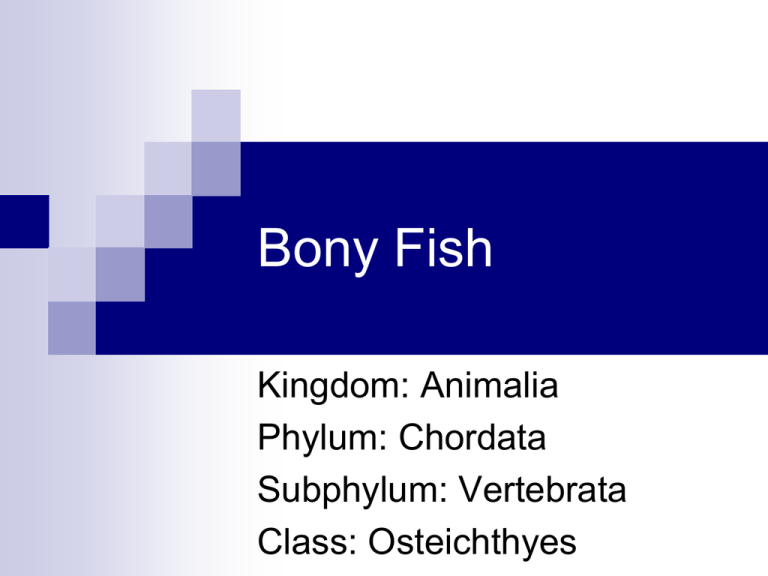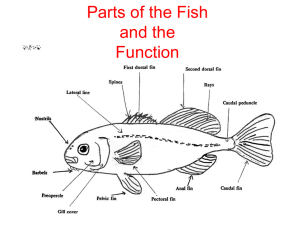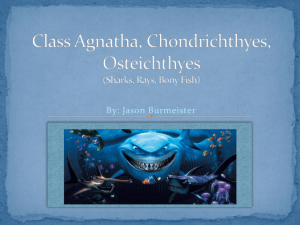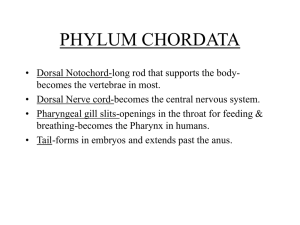
Bony Fish
Kingdom: Animalia
Phylum: Chordata
Subphylum: Vertebrata
Class: Osteichthyes
Class Osteichthyes
“Bony Fish”
Skeleton made of
bone
Thin, flexible scales
Class Osteichthyes
Operculum – a gill
cover that protects
the gills
Swim Bladder – a
gas-filled sac above
the stomach allows
for adjustments in
buoyancy
Fins
Fins
Upper and lower
lobes of Caudal Fin
almost always the
same size
Fin rays – rigid spines
that support a thin
membrane
Mouth & Jaws
Mouth of most bony
fish is terminal or
anterior end
Overall jaw
movement is more
than that of sharks
with teeth that are
fused to jaw
Feeding
Most bony fish are
carnivores
Well developed teeth
used for capture and
holding
Roof of mouth, gill
rakers, and pharynx
may have teeth to
help hold
Feeding
Grazers – fish that
feed primarily on
seaweeds and other
plants
Some develop beaks
to help scrape off
algae or pieces of
coral
Feeding
Filter feeders filter
plankton through their
gills
Tend to be smaller,
schooling fish such as
herrings, anchovies,
and sardines
Internal Anatomy
Digestive System
Digestive System: stomach, intestine, pancreas, liver,
pyloric caecae
Pyloric caecae – slender tubes that secrete digestive
enzymes
Plant eaters = long intestine, Meat eaters = short
intestines
Circulatory System
Two chambered heart
Gas exchange occurs in the gills
Gill Irrigation
Gills share a common
gill chamber
Mouth opens,
operculum closes, and
pharynx expands to
allow in water and the
opposite is true
Fast swimmers just
open their mouths
Nervous System
Brain & spinal cord
Olfactory sacs or bulbs located on either side of
the head and connected to nostrils (smell)
Taste buds located in mouths or barbels
Vision
Better eyes than
chondrichthyes
Fish eyes focus by
moving closer or
farther away from
subject
Many have color
vision
Hearing
Presence of inner ears
Chambers similar to the
lateral line
Located on either side of
the head just behind the
brain
Can resonate/amplify
sound through swim
bladder
Lateral Line
Detects vibrations in
water
Small canals filled
with sensory cells
Behaviors
Territories – home
areas that fish defend
against intruders
Most common in
crowded
environments
Some defend as
groups
Behaviors
Schools – well defined
groups of fishes
Well coordinated with no
leaders
Used a protection by
confusion
Increase swimming
efficiency
Advantageous in feeding
No single reason and
vary species to species
Behavior
Migration – regular
mass movements
from one place to
another
Anadromous fish –
live mostly at sea and
migrate to freshwater
to breed (salmon)
Catadromous fish –
breed a sea and live
in rivers (eels)
Subclass Dipnoi
“Lungfish”
Jaw fused to brain
case
Caudal, dorsal, and
anal fin connected
Pectoral fins long and
tubular
Air breathing organ
attached to
esophogus
Subclass Crossopterygii
“Coelacanths”
Cosmoid scale
Two dorsal fins and
fleshy paired fins with
skeletal elements
Thought to be extinct till
found
Sometimes grouped with
lungfish in Subclass
Sarcopterygii
Subclass Actinopterygii
Ray-finned fishes
Most familiar fish
Have fin rays, swim
bladders, and a
symmetrically lobed
caudal fin
Birds, lizards, turtles, dinosaurs, mammals
Lungfish
Cartilaginous Fish
Lobed-Finned Fish
Ray-Finned Fish
Jawed Vertebrates
Subclass Actinopterygii
Superorder Teleostei
Superorder Holostean
Bass
Garpikes
Goldfish
Bowfins
Guppies
Seahorses
Sturgeons
Tuna
Etc.
Superorder
Chondrostei
Freshwater Sturgeon
Bichirs
Paddlefish
Reedfish
Superorder Holostean
Fin arrangements
make for more
efficient swimmers
Superorder Chondrostei
Lack bone
Sometimes classified
with sharks
Though more in
common with the
telosts
Superorder Telostei
Most prolific class
96% of all fish
12 suborders
Symmetrical caudal
fin
Spines on fins
Osteoglossmorpha
Order Osteoglossiformes
Order Hiodontiformes
Elopomorpha
Order Elopiformes
Order Albuliformes
Order Notacanthiformes
Order Anguilliformes
Order
Saccopharyngiformes
Clupeomorpha
Order Clupeiformes
Ostariophysi
OrderGonorynchiformes
Order Cypriniformes
Order Characiformes
Order Gymnotiformes
Order Silurioformes
Protacanthopterygii
Order Salmoniformes
Order Escociformes
Order Osmeriformes
Stenopterygii
Order Ateleopodiformes
Order Stomiiformes
Cyclosquamata
Order Aulopiformes
Scopelomorpha
Order Myctophiformes
Lampridiomorpha
Order Lampriformes
Polymyxiomorpha
Order Polymixiiformes
Paracanthopterygii
Order Percopsiformes
Order Batrachoidiformes
Order Lophiiformes
Order Gadiformes
Order Ophidiiformes
Acanthopterygii
Order Mugiliformes
Order Atheriniformes
Order Beloniformes
Order Cetomimiformes
Order Cyprinodontiformes
Order Stephanoberyciformes
Order Bericiformes
Order Zeiformes
Acanthopterygii
Order Gobiescociformes
Order Gasterosteiformes
Order Syngnathiformes
Order Synbranchiformes
Order Tetraodontiformes
Order Pleuronectiformes
Order Scorpaeniformes
Order Perciformes
- 46% of fish












